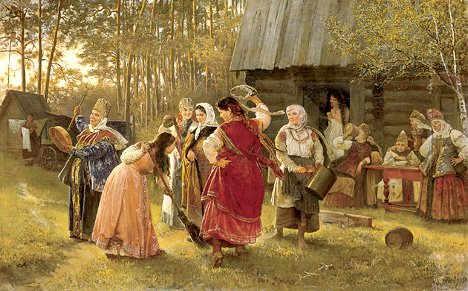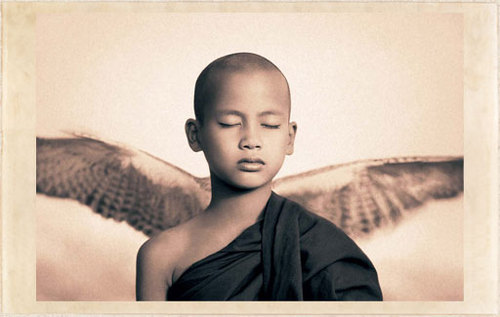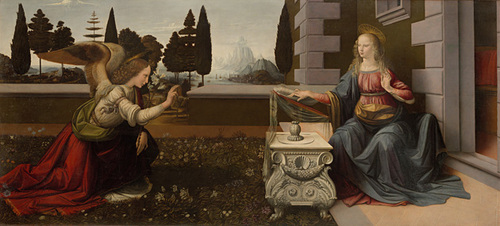Ashes & Snow is a photography and film exhibit in a temporary building at Odaiba. Gregory Colbert has a vision and he’s spent years travelling the world capturing interactions between people and animals: monks and elephants; a dancer and a hawk; women and anteaters. Sounds strange? It is, but so quiet and meditatively wonderful, that I cried pretty much the entire two hours I was there.
The photographs are printed huge and hanging in space forming the walls of the corridors that lead to and from the film. They are not labelled, inviting you to actually look at them and figure them out. I took my time with them, and was rewarded with echoing patterns and little surprises hidden in reflections. Although the 60 minute film, which is related to the photographs, feels a little too contrived, it was so beautiful to watch that the moment after I started drifting off and thinking “OK, this is going to be over soon, right?’ or “How did he manage to do that?” i was pulled back into the moment by a new and beautiful scene. Personally, I think he could have cut out some of the repetition of similar scenes in different locations, but really, that’s a small editorial niggle.
The temporary museum structure is breathtaking, too. It’s vast but clever lighting arrangements make it feel cozy. A contradiction built of cargo containers, tenting and cardboard.
In short, you must go to this one. It runs through June 24th in the parking lot near Venus Fort and Decks at Odaiba.
The Mind of Leonardo - Universal Genius at Work is showing at the Tokyo National Museum. I got a free pass from a friend who works at the museum and spent an enjoyable hour and a half exploring.
The first part of the exhibit is a single painting - the Annunciation, the first painting completed by Da Vinci after his apprenticeship. He was in his 20s. It’s a lovely painting, more beautiful close up than far away, but you don’t get to spend too much time with it as you and everyone else shuffle past in a slow queue. But getting up close is totally worth the line, though I was there on a day when it wasn’t too busy. I suspect that on a weekend, the wait might be intolerable.
The second part of the exhibit is in another building entirely and it tries to take a holistic view of Da Vinci’s thinking and philosophy. Although he studies and worked in many disciplines - motion, anatomy, painting - he didn’t think of them as different things. They were all interconnected. That didn’t seem like a major revelation to me, but then I dabble in different things and I know they for me they are interconnected, so why not for DaVinci, too?
I particularly enjoyed looking at some of the Codex that was on display. It reinforces my idea that you should keep notebooks and journals and record your ideas in them. His were greatly interesting and surprisingly not beautiful works of art, but working sketches and notes. They looked very little different from things I’ve seen in my friends’ Moleskines.
The exhibit included were numerous video explanations of things - simulations of how his inventions would have worked and his ideas on anatomical geometry were quite illuminating and entertaining.
If you’re interested in a well-presented multi-disciplinary exhibit, this one is for you. Runs through June 17th at the Tokyo National Museum in Ueno.

Masterpieces of the State Russian Museum from Late 18th Century to Early 20th Century (what a title!) may the the summer sleeper of museum exhibits. I went to the opening yesterday (courtesy of my friend, again!) not quite sure what to expect. I find that the Tokyo Metropolitan Art Museum generally bites - its rental galleries are often full of art club exhibitions.
But this exhibit was good. Well-documented and organised, the exhibition takes you from classical paintings in the time of Catherine II through later portraiture of “regular people” into the dark depressing times of poverty and Dostoevsky and back into the light with bold colors of the early 20th century.
There are heroic ocean storms, humorous insights into village life (Hen Party was a favorite), and heart-string tuggers of ragged beggars. If you pay attention, you get an overview not only of the changing style of art, but the changing lives of Russians during this period.
And at the end of the gallery walk, you’ll find a shop that sells Russian breads made in Yokohama. Needless to say, I bought some. How can I pass up bread?
This show runs through July 8th at the Tokyo Metropolitan Art Museum, Ueno. There’s a theremin concert on May 12th. Maybe I’ll see you there?
Posted by kuri at April 28, 2007 10:43 AM

